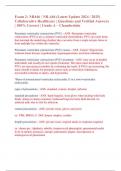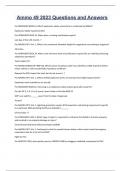Exam 2: NR446 / NR-446 (Latest Update )
Collaborative Healthcare | Questions and Verified Answers
| 100% Correct | Grade A – Chamberlain
Premature ventricular contractions (PVC) - ANS -Premature ventricular
contractions (PVCs) are a common ventricular dysrhythmia. PVCs are early beats
that interrupt the underlying rhythm; they can arise from a single ectopic focus or
from multiple foci within the ventricles.
Premature ventricular contractions (PVC) causes - ANS -Causes: Hypoxemia,
ischemic heart disease, hypokalemia, hypomagnesemia, acid-base imbalances
Premature ventricular contractions (PVC) treatment - ANS -may occur in healthy
individuals and usually do not require treatment. The nurse must determine if
PVCs are increasing in number by evaluating the trend. If PVCs are increasing, the
nurse should evaluate for potential causes such as electrolyte imbalances,
myocardial ischemia or injury, and hypoxemia.
*Runs of nonsustained ventricular tachycardia (3 in a row)=ventricular
tachycardia.
types of precautions - ANS -standard, contact, droplet, airborne
standard precautions - ANS -hand hygiene, wear glove when dealing with body
fluids, sharps in sharp-container, biohazard bags for body fluid discard, no
artificial nails due to risk for infection
contact precautions - ANS -private room, gloves and gown
ex. VRE, MRSA, C. Diff, herpes simplex, scabies
droplet precautions - ANS -private room, surgical mask or respirator required
ex. chemo pts., diptheria, rubella, streptococcal pharyngitis, pneumonia/scarlet
fever in infants, pertussis, mumps, pneumonic plague, mycoplasma or
meningococcal pneumonia
,airborne precautions - ANS -private room, negative pressure, N95 mask/respiratory
protection device
ex. pulmonary or laryngeal TB, measles, chickenpox (varicella)
*pt should wear mask out of the room if transferring/transporting
types of insulin - ANS -rapid-acting, short-acting, intermediate-acting and long-
acting, combination therapy (premixed)
rapid-acting insulin - ANS -lispro (Humalog), aspart (NovoLog), glulisine (Apidra)
*onset 10-30 min
*peak 30min-1hr
duration 3-5hr
short-acting insulin - ANS -regular (Humulin R or Novolin R)
*onset 30min-1hr
*peak 2-5 hr
*duration 5-8hr
intermediate-acting insulin - ANS -NPH (Humulin N or Novolin N)
*onset 1.5-4hr
*peak 4-12hr
*duration 12-18hr
long-acting insulin - ANS -glargine (Lantus), detemir (Levemir)
*onset 0.8-4hr
*no pronounced peak
*duration 24+hrs
forecasting - ANS -involves trying to estimate how a condition will be in the
future; this mode of planning takes advantage of input from others, gives sequence
in activity, and protects an organization against undesirable changes
reactive planning mode - ANS -occurs after a problem exists. efforts are directed at
returning the organization from a state of crisis to a previous, more comfortable
, state, so problems are dealt with separately w/o integration with the whole
organization; can lead to hasty decisions and mistakes.
preactive planning mode - ANS -future- oriented and utilize technology to
accelerate change. unsatisfied with the past or present, they do not value
experience and believe that the future is always preferable to the present.
proactive/interactive planning mode - ANS -past, present and future planning
(anticipates change); they try to plan the future of their organization rather than
react to it. is dynamic and adaptation is considered a key requirement since the
environment changes so frequently. In anticipation to changing needs or to
promote growth within the org, it is required of all leader-managers that personal
as well as organizational needs and objectives are met.
inactivism planning mode - ANS -seeking the status quo by spending there time
and energy preventing change and maintaining conformity; when changes do occur
they happen slowly and incrementally.
strategic planning - ANS -examines an organization's purpose, mission,
philosophy, and goals in the context of its external environment. Strategic goals
and objectives are identified, stakeholders are identified and strategies to achieve
the goals will be developed.
strategic plans - ANS -Strategic plans are based on and goals are aligned with the
mission of the organization. Usually long term (3-10 years) and are considered
historical patterns
long range planning - ANS -any planning that is at least 6 months in the future may
be considered
SWOT analysis
- ANS -S-Strengths: are those internal attributes that help an organization to
achieve its objectives
W- Weaknesses: are those internal attributes that challenge an organization in
achieving its objectives
O-Opportunities: are external conditions that promote achievement of
organizational objectives
T- Threats: are external conditions that challenge or threaten the achievement of
organizational objectives





